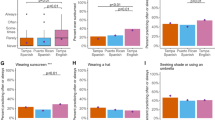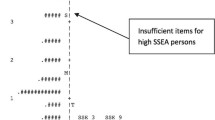Abstract
The study’s purpose was to select/refine measures assessing psychosocial constructs associated with skin cancer risk/protective behaviors. Cognitive interviewing was conducted with twenty participants locally, and a survey was conducted with 965 adults aged 18–25 years at moderate to high risk of developing skin cancer, recruited nationally online. Psychosocial measures assessed variables from the Integrative Model of Behavior Prediction. As a result of expert review and cognitive interviewing, items were removed, added, and/or made simpler, more personal, consistent, and less ambiguous. A factor analysis resulted in 14 scales and adequate model fit. Internal reliability and test–retest reliability was acceptable to good. Correlations among the psychosocial and behavioral variables were generally significant and in expected directions, demonstrating convergent validity. We have refined measures that assess important psychosocial constructs associated with skin cancer-related behaviors, that research participants can understand and complete successfully, and that are reliable and demonstrate evidence for validity.
Similar content being viewed by others
References
Andrews, J. A., Tildesley, E., Hops, H., & Li, F. (2002). The influence of peers on young adult substance use. Health Psychology, 21, 349–357.
Arthey, S., & Clarke, V. A. (1995). Suntanning and sun protection: A review of the psychological literature. Social Science and Medicine, 40, 265–274.
Berrigan, D., Forsyth, B. H., Helba, C., Levin, K., Norberg, A., & Willis, G. B. (2010). Cognitive testing of physical activity and acculturation questions in recent and long-term Latino immigrants. BMC Public Health, 10, 481. doi:10.1186/1471-2458-10-481
Bleyer, A., & Barr, R. (2009). Introduction—Impact of malignant diseases on young adults II. Seminars in Oncology, 36, 380. doi:10.1053/j.seminoncol.2009.07.002
Bowen, A. M., Daniel, C. M., Williams, M. L., & Baird, G. L. (2008). Identifying multiple submissions in Internet research: Preserving data integrity. AIDS and Behavior, 12, 964–973. doi:10.1007/s10461-007-9352-2
Buller, D. B., Cokkinides, V., Hall, H. I., Hartman, A. M., Saraiya, M., Miller, E., et al. (2011). Prevalence of sunburn, sun protection, and indoor tanning behaviors among Americans: Review from national surveys and case studies of 3 states. Journal of the American Academy of Dermatology, 65, S114–S123. doi:10.1016/j.jaad.2011.05.033
Buller, D. B., Reynolds, K. D., Yaroch, A., Cutter, G. R., Hines, J. M., Geno, C. R., et al. (2006). Effects of the Sunny Days, Healthy Ways curriculum on students in grades 6 to 8. American Journal of Preventive Medicine, 30, 13–22. doi:10.1016/j.amepre.2005.08.046
Cafri, G., Thompson, J. K., Roehrig, M., van den Berg, P., Jacobsen, P. B., & Stark, S. (2006). An investigation of appearance motives for tanning: The development and evaluation of the Physical Appearance Reasons For Tanning Scale (PARTS) and its relation to sunbathing and indoor tanning intentions. Body Image, 3, 199–209. doi:10.1016/j.bodyim.2006.05.002
Coups, E. J., Manne, S. L., & Heckman, C. J. (2008). Multiple skin cancer risk behaviors in the U.S. population. American Journal of Preventive Medicine, 34, 87–93. doi:10.1016/j.amepre.2007.09.032
Dillman, D. A., Smyth, J. D., & Christian, L. M. (2008). Internet, mail, and mixed-mode surveys: The tailored design method (3rd ed.). Hoboken, NJ: Wiley Publishing.
Fishbein, M., Hennessy, M., Yzer, M., & Douglas, J. (2003). Can we explain why some people do and some people do not act on their intentions? Psychology, Health & Medicine, 8, 3–18. doi:10.1080/1354850021000059223
Fortune-Greeley, A. K., Flynn, K. E., Jeffery, D. D., Williams, M. S., Keefe, F. J., Reeve, B. B., et al. (2009). Using cognitive interviews to evaluate items for measuring sexual functioning across cancer populations: Improvements and remaining challenges. Quality of Life Research, 18, 1085–1093. doi:10.1007/s11136-009-9523-x
Freedman, K. S., Nelson, N. M., & Feldman, L. L. (2012). Smoking initiation among young adults in the United States and Canada, 1998–2010: A systematic review. Preventing Chronic Disease, 9, 110037.
Galliher, R. V., & Kerpelman, J. L. (2012). The intersection of identity development and peer relationship processes in adolescence and young adulthood: Contributions of the special issue. Journal of Adolescence, 35, 1409–1415. doi:10.1016/j.adolescence.2012.09.007
Gibbons, F. X., Gerrard, M., Lane, D. J., Mahler, H. I., & Kulik, J. A. (2005). Using UV photography to reduce use of tanning booths: A test of cognitive mediation. Health Psychology, 24, 358–363.
Glanz, K., Schoenfeld, E., Weinstock, M. A., Layi, G., Kidd, J., & Shigaki, D. M. (2003). Development and reliability of a brief skin cancer risk assessment tool. Cancer Detection and Prevention, 27, 311–315.
Glanz, K., Yaroch, A. L., Dancel, M., Saraiya, M., Crane, L. A., Buller, D. B., et al. (2008). Measures of sun exposure and sun protection practices for behavioral and epidemiologic research. Archives of Dermatology, 144, 217–222. doi:10.1001/archdermatol.2007.46
Heckman, C. J., Coups, E. J., & Manne, S. L. (2008). Prevalence and correlates of indoor tanning among US adults. Journal of the American Academy of Dermatology, 58, 769–780. doi:10.1016/j.jaad.2008.01.020
Hillhouse, J. J., Turrisi, R., & Kastner, M. (2000). Modeling tanning salon behavioral tendencies using appearance motivation, self-monitoring and the theory of planned behavior. Health Education Research, 15, 405–414.
Holman, D. M., & Watson, M. (2013). Correlates of intentional tanning among adolescents in the United States: A systematic review of the literature. The Journal of Adolescent Health: Official Publication of the Society for Adolescent Medicine, 52, S52–S59. doi:10.1016/j.jadohealth.2012.09.021
Ingledew, D. K., Ferguson, E., & Markland, D. (2010). Motives and sun-related behaviour. Journal of Health Psychology, 15, 8–20. doi:10.1177/1359105309342292
Irwin, B., Mauriello, D., Hemminger, L., Pappert, A., & Kimball, A. B. (2007). Skin sun-acne tutorial evaluation among middle- and high-school students in central New Jersey. Journal of the American Academy of Dermatology, 56, 407–412. doi:10.1016/j.jaad.2006.11.028
Jackson, K. M., & Aiken, L. S. (2000). A psychosocial model of sun protection and sunbathing in young women: The impact of health beliefs, attitudes, norms, and self-efficacy for sun protection. Health Psychology, 19, 469–478.
Jackson, K. M., & Aiken, L. S. (2006). Evaluation of a multicomponent appearance-based sun-protective intervention for young women: Uncovering the mechanisms of program efficacy. Health Psychology, 25, 34–46.
Keeney, S., McKenna, H., Fleming, P., & McIlfatrick, S. (2009). Attitudes, knowledge and behaviours with regard to skin cancer: A literature review. European Journal of Oncology Nursing, 13, 29–35. doi:10.1016/j.ejon.2008.11.004
Krosnick, J. A., & Presser, S. (2010). Questions and questionnaire design. In J. D. Wright & P. V. Marsden (Eds.), Handbook of survey research (2nd ed.). West Yorkshire: Emerald Group.
Lazovich, D., Stryker, J. E., Mayer, J. A., Hillhouse, J., Dennis, L. K., Pichon, L., et al. (2008). Measuring nonsolar tanning behavior: Indoor and sunless tanning. Archives of Dermatology, 144, 225–230. doi:10.1001/archdermatol.2007.45
Linzer, D. A., & Lewis, J. (2011). poLCA: An R package for polytomous variable latent class analysis. Journal of Statistical Software, 42, 1–29.
Linzer, D. A., & Lewis, J. (2013). poLCA: Polytomous variable latent class analysis. R package Version 1.4. http://dlinzer.github.com/poLCA
Maddock, J. E., Redding, C. A., Rossi, J. S., & Weinstock, M. A. (2005). Development and validation of an appearance motivation attitudes scale for sun protection. Psychology & Health, 20, 775–788.
Mahler, H. I., Kulik, J. A., Gerrard, M., & Gibbons, F. X. (2010). Effects of upward and downward social comparison information on the efficacy of an appearance-based sun protection intervention: A randomized, controlled experiment. Journal of Behavioral Medicine, 33, 496–507. doi:10.1007/s10865-010-9279-3
Matsunaga, M. (2010). How to factor-analyze your data right. International Journal of Psychological Research, 3, 97–110.
Meade, A. W., & Craig, S. B. (2012). Identifying careless responses in survey data. Psychological Methods, 17, 437–455. doi:10.1037/a0028085
Patrick, D. L., Burke, L. B., Gwaltney, C. J., Leidy, N. K., Martin, M. L., Molsen, E., et al. (2011). Content validity—Establishing and reporting the evidence in newly developed patient-reported outcomes (PRO) instruments for medical product evaluation: ISPOR PRO Good Research Practices Task Force report: Part 2—Assessing respondent understanding. Value Health, 14, 978–988. doi:10.1016/j.jval.2011.06.013
Pinard, C. A., Uvena, L. M., Quam, J. B., Smith, T. M., & Yaroch, A. L. (2015). Development and testing of a revised cooking matters for adults survey. American Journal of Health Behavior, 39(6), 866–873.
Raiche, G. (2010). nFactors: An R package for parallel analysis and non graphical solutions to the Cattell scree test. R package version 2.3.3.
Rennie, K. M. (1997). Exploratory and confirmatory rotation strategies in exploratory factor analysis. Paper presented at the annual meeting of the southwest educational research association
Revelle, W. (2015). psych: Procedures for personality and psychological research (Version 1.5.1). Evanston, IL: Northwestern University. Retrieved from http://CRAN.R-project.org/package=psych
Stanton, W. R., Janda, M., Baade, P. D., & Anderson, P. (2004). Primary prevention of skin cancer: A review of sun protection in Australia and internationally. Health Promotion International, 19, 369–378. doi:10.1093/heapro/dah31019/3/369
Subar, A. F., Thompson, F. E., Smith, A. F., Jobe, J. B., Ziegler, R. G., Potischman, N., et al. (1995). Improving food frequency questionnaires: A qualitative approach using cognitive interviewing. Journal of the American Dietetic Association, 95, 781–788. (quiz 789–790).
Taherdoost, H. S., Sahibuddin, S., & Jalaliyoon, N. (2014). Exploratory factor analysis; concepts and theory. Paper presented at the international conference on mathematical-computational and statistical-sciences, Gdansk-Wrzeszcz, Poland.
Tripp, M. K., Vernon, S. W., Gritz, E. R., Diamond, P. M., & Mullen, P. D. (2013). Children’s skin cancer prevention: A systematic review of parents’ psychosocial measures. American Journal of Preventive Medicine, 44, 265–273. doi:10.1016/j.amepre.2012.10.027
Willis, G. B. (Ed.). (2005). Cognitive interviewing: A tool for improving questionnaire design. Thousand Oaks, CA: Sage.
Willis, G. B., & Artino, A. R., Jr. (2013). What do our respondents think we’re asking? Using cognitive interviewing to improve medical education surveys. Journal of Graduate Medical Education, 5, 353–356. doi:10.4300/JGME-D-13-00154.1
Wolfe, W. S., Frongillo, E. A., & Cassano, P. A. (2001). Evaluating brief measures of fruit and vegetable consumption frequency and variety: Cognition, interpretation, and other measurement issues. Journal of the American Dietetic Association, 101, 311–318. doi:10.1016/S0002-8223(01)00081-5
Acknowledgements
We are indebted to Teja Munshi for her assistance with data management, Jennifer Burns and the Resource and Education Center at Fox Chase Cancer Center for their assistance with user testing, as well as the young adults who participated in the study.
Funding
This study was funded by R01CA154928 (CH), T32CA009035 (SD), and P30CA006927 (Cancer Center Support Grant).
Author information
Authors and Affiliations
Corresponding author
Ethics declarations
Conflict of interest
C. J. Heckman, E. Handorf, S. D. Darlow, A. L. Yaroch, and S. Raivitch declare that they have no conflict of interest.
Human and animal rights and Informed consent
All procedures performed in studies involving human participants were in accordance with the ethical standards of the institutional and/or national research committee and with the 1964 Helsinki declaration and its later amendments or comparable ethical standards. Informed consent was obtained from all individual participants included in the study.
Electronic supplementary material
Below is the link to the electronic supplementary material.
Rights and permissions
About this article
Cite this article
Heckman, C.J., Handorf, E., Darlow, S.D. et al. Refinement of measures to assess psychosocial constructs associated with skin cancer risk and protective behaviors of young adults. J Behav Med 40, 574–582 (2017). https://doi.org/10.1007/s10865-017-9825-3
Received:
Accepted:
Published:
Issue Date:
DOI: https://doi.org/10.1007/s10865-017-9825-3




